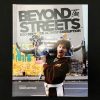This is the first piece from a series of interviews that will explore the world of collage by delving into the very foundation of an artist’s expression: their source material. Appropriation, the act of taking existing materials and infusing them with new meaning, lies at the heart of collage’s ideology. But the beauty of this art form lies in its diversity – while the principle of appropriation unites all collagists, the specific materials they choose (and why) reveal unique artistic identities and perspectives. It’s this personal touch that fascinates us, and through these interviews, we aim to uncover the stories behind the art, understanding what sparks an artist’s imagination and compels them to select, transform, and ultimately, breathe new life into existing materials.
In this first interview, our own Max-o-matic talks about his source materials and what he decides to appropriate and why.
Text by Max-o-matic

Imagine meticulously sifting through the archives of history, not just for forgotten trinkets, but for forgotten narratives nestled within vintage magazines. While some collage artists meticulously excavate relics of bygone eras, my gaze takes a different approach – towards the vast digital library of stock photos, those ubiquitous, easily overlooked images saturating our online world.
These stock photos might seem banal, but it’s that banality that fuels my artistic pursuit. The images that we can find in royalty free image banks whisper untold stories, reflecting our contemporary anxieties, dreams, and the carefully constructed masks we wear in the digital age. Every forced grin echoes an under looked narrative, begging to be reinterpreted and brought back to light.
But I’m not simply a contemporary archivist. I actively engage with the discarded narratives of our time. Stock photos, in their ordinariness, become mirrors reflecting the carefully constructed images we choose to present. In contrast to Life Magazine’s curated portrayals, stock photos offer a raw, unfiltered glimpse into mainstream cultural perceptions of people and society.
Like forgotten old issues of Life magazines collecting dust back in mid 20th century, stock photos saturate our world, readily available but rarely valued. Dismissed as uninspiring, they lack the perceived artistic merit of other mediums. Yet, it’s their very overlooked nature that fuels my exploration.

However, unlike an archaeologist carefully preserving artifacts, I’m not afraid to break through the established boundaries. Here’s where my approach takes a twist – instead of solely relying on vintage magazines, when I want to use source images from past eras or when I look to work with paper and connect with its tactile nature, I weave vibrant threads from another source: brand new published books.
This choice is deliberate. These fresh-off-the-press publications aren’t simply echoes of bygone eras; they’re curated narratives, carefully selected by contemporary culture to shine a light on specific aspects of the past. This deliberate act of highlighting raises questions – why is this specific story relevant now? Why is this published today and not other things? By incorporating these narratives into my collages, I’m not just repurposing images; I’m challenging the very selection process itself.
In a thoughtful act of subversion, I take these meticulously chosen fragments and juxtapose them with the digital realm, asking viewers to contemplate the ideological implications of both. Each cut and paste becomes a question mark, prompting viewers to examine how history is constantly rewritten through the lens of the present. What was once hidden might be unearthed, while other stories fade into the background, reminding us that history is an ever-evolving conversation, constantly shaped by the present’s perspective.

Ultimately, my collages are more than just repurposed images; they’re mosaics of past, present, and pixelated dreams. They’re invitations to delve deeper, to question the narratives we consume, to challenge the surface-level fluff of readily available visuals, and to ponder the ethical complexities of reusing and recontextualizing cultural ephemera. Through these layers of stories, I hope to ignite a deeper understanding of the collective narrative we create, reminding us that every image, every story, deserves its moment in the spotlight – whether it’s a faded magazine clipping, a pixelated snippet of the digital age, or a curated chapter from a brand new book, waiting to be reinterpreted and confront its own relevance in our ever-evolving present.
Lean more about Max-o-matic’s work here at TWS, on his website, or on Instagram.






